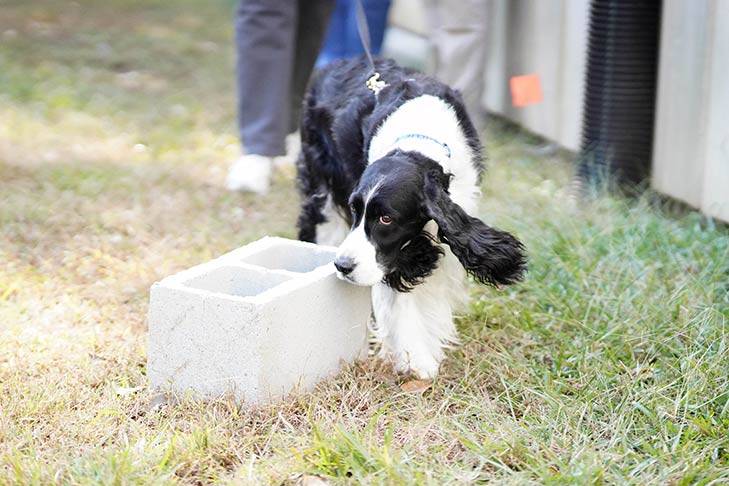Participating in dog sports with your dog can provide mental and physical exercise, the thrill of competition, and a chance for you both to have fun. If you’re the owner of a senior dog, you might think your dog sports days are behind you. Fortunately, there are many sports that are suited to dogs of any age (if your veterinarian approves, of course). In fact, many senior dogs are still top ranking in their respective sport.
Scent Work
No matter their age, dogs experience the world through smell. Scent Work taps into their olfactory instincts and lets them truly enjoy the power of their noses. During a scent work trial, dogs search for hidden cotton swabs that are doused with essential oils or with their owner’s scent, depending on the class. The search can be conducted in a variety of environments, known as elements, including “container” (the dog must search through a number of containers, like cardboard boxes or suitcases), “interior” (a search in an indoor area in an everyday setting), “exterior” (an everyday outdoor area with vegetation), and “buried” (the target scent is buried under the ground).
Unlike other dog sports, where the dog has to obey the handler, in Scent Work the dog is in charge. The handler doesn’t know where the swab is hidden, and without a dog’s sense of smell, has no way of easily finding it. The handler depends on the dog to locate the swab and communicate its location to complete a successful trial.
You can also take the Virtual Scent Work Test (VSWT) to work on the skills with your older dog at home.

Tracking
Tracking is another sport that lets your dog and his nose take the lead. In this case, your dog follows a trail in an open field or urban environment and retrieves items along that trail. There are four titles your dog can earn in tracking, with three increasing levels of difficulty. At the lowest level, the track is between 440 and 500 yards long, with 3 to 5 changes in direction. The scent trail is anywhere from half an hour to two hours old, and the dog needs to indicate a glove or wallet placed at the end of the trail. Higher levels involve older scent trails, longer tracks, and more items for the dog to recover.
Your senior dog already knows how to follow their nose; they’ve been doing it for years. The trick is to teach them what scent you want them to track and to do it when asked. There is no time limit in this activity, as long as your dog is working, so your older dog can walk as slowly as necessary. If they follow the track and find the articles, they will earn the appropriate title.
Obedience
You likely left obedience training behind when your senior dog was younger, but competing in Obedience trials is a great way to have fun and show off your older dog’s good behavior. Judges rate dog and handler teams as they follow specified routines in an obedience ring, and scores are determined by how closely the team matches a theoretically perfect performance.
Titles are earned through three different levels of difficulty — novice, open, and utility. Each level builds on the level below, and the skills involved include behaviors such as heeling, standing for a simple examination, retrieving, and staying in a sit and down position within a group of dogs. Once your dog makes it to the open class, jumping tests are added to the exercises, which could be challenging for a dog with arthritis or other physical ailments.
There is also the Virtual Obedience Test program, which offers Virtual Beginner Novice and Virtual Novice classes for your dog to comfortably do at home.

Rally
Rally is another sport that allows you to demonstrate your dog’s obedience skills. Moving at their own pace, a dog and handler complete a course consisting of 10 to 20 exercise skill stations. At each station, there is a sign with instructions about the skill to be performed. This is a timed event. Every team starts with 100 points and loses points for errors, and in the case of a tie, the fastest team wins.
There are three classes that increase in difficulty — Rally Novice, Rally Advanced, and Rally Excellent, which can also be done virtually. Scoring is not as rigorous as in traditional obedience trials, and communicating with the dog is encouraged. At lower levels of competition, handlers can clap their hands, pat their legs, and talk to and praise their dog during the trial. Be aware that there is some jumping once your dog reaches the level of Rally Advanced, so this may be a concern depending on your dog’s physical health.
Trick Training
Old dogs can learn new tricks, and if you use positive training methods, they will love doing it. You likely taught the basic obedience behaviors long ago, but if you venture into tricks, there is no end to the behaviors you can continue to teach. Your dog will learn new vocabulary and be challenged mentally. Also, your training skills will improve, your bond with your dog will strengthen, and you can show off your dog’s trick routine to friends and family.
Your dog can also earn titles for trick work, either through Do More With Your Dog!, AKC Trick Dog, or AKC Virtual Trick Dog. There are varying levels of difficulty, starting with novice, and each level builds on the one below. Each level has a list of tricks to choose from, including a handler’s choice option where you can design your own trick suitable to your dog. That means there is an endless number of tricks to choose from, so you’re sure to find something perfect for your dog’s size, style, and physical abilities.

